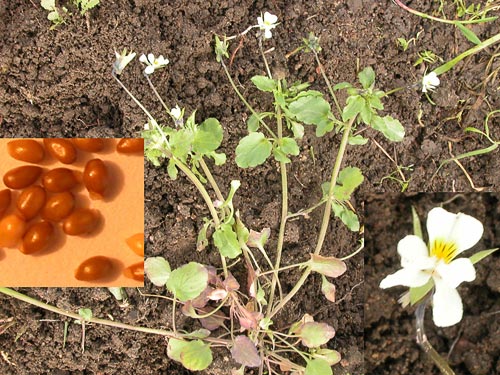Weeds
Viola arvensis Murr. - European field pansy, field violet.
Taxonomy.
Family Violaceae, Genus Viola. Polymorphic species, capable to hybridize with V. tricolor L., V. matulina Klok., V. nemausensis Jord., and other species.Biology type.
Annual or perennial; there are winter forms and spring forms.Morphology and biology.
Stem is upright, simple or branched, downy, of 5-50 cm in height. Basal leaves are small, spatulate, leaf plate is almost rounded, covered by sparse hairs, on comparatively long petioles; middle leaves are oblong obovate, on short petioles; upper leaves are oblong lanceolate with barely visible petioles; middle and upper leaves have pinnatiparite stipules with larger final lobe. Flovers are single, small, 11 mm in length, zygomorphic, on long peduncles (2-12 cm). Corolla is usually pale-yellow, with bright yellow lower petals and sometimes violet upper petals. Fruit is boll, almost rounded, with short (0.1-0.7 mm), thick top, which is cut on top; dry, hard, three-leaved, glabrous, dark-sandy-colored, containing many seeds. Valves are scaphoid. There is a longitudinal wide shaft (1.7-2.0 mm) in the center of each valve. Fruits open along the middle nerve of the carpels. Parts of perianths remain around fruits. Seeds are obovate, slightly squeezed, strongly sharpened at the base, from yellow to tan-colored, with dark-brown seed suture, glossy, more rare dull, with fine-wrinkled surface, 1.5-1.8 mm in length. Shoots emerge in April-May or August-September. Flowering occurs from April until September, fruiting; from June until October. Propagation is by seeds, the maximum production of a plant reaches 3200 seeds. Decumbent stem sometimes roots at nodes.Distribution.
Everywhere in Europe, western and eastern Siberia, as an introduced species recorded in different districts of Central Asia, Asia Minor, and North America.Ecology.
Grows in open places, preferring fertile soils. Seeds germinate after dormancy over a period of 6-8 months. Seeds keep their germinating capacity up to 6 years. Minimal temperature of germination is 2-3 °C, optimal; 18-24 °C.Economic value.
Weed plants of various crops (winter and spring cereals, tilled crops). Especially harmful to seedlings of crops because it develops faster. Control measures: weeding; early superficial shelling following winter tillage; harrowing before sowing of spring cereals; for tilled crops: inter-row treatments; crop rotations; chemical control when necessary.Reference citations:
Komarov, V.L., ed. 1935. Flora of the USSR. Leningrad: Acad. Sci. USSR. V. 15: 468.Popov, M.G. 1957. Flora of Central Siberia. Moscow-Leningrad: Acad. Sci. USSR. V. 1: 454.
Tikhonova Z.E. 1937. Weeds and their control measures. Gorkii: Gorkovskij Region Publishing House. 97 p.
Tshesalin G.A. 1975. Weeds and their control measures. Moscow: Kolos. 256 p.


